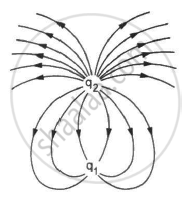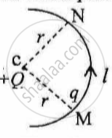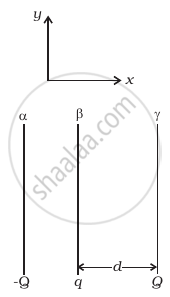Advertisements
Advertisements
Question
A point charge is taken from a point A to a point B in an electric field. Does the work done by the electric field depend on the path of the charge?
Solution
Electrostatic field is a conservative field. Therefore, work done by the electric field does not depend on the path followed by the charge. It only depends on the position of the charge, from which and to which the charge has been moved.
APPEARS IN
RELATED QUESTIONS
Why can one ignore quantisation of electric charge when dealing with macroscopic i.e., large scale charges?
Consider the situation shown in the figure. What are the signs of q1 and q2? If the lines are drawn in proportion to the charges, what is the ratio q1/q2?

When a charged comb is brought near a small piece of paper, it attracts the piece. Does the paper become charged when the comb is brought near it?
In Figure 1 below, a charge Q is fixed. Another charge q is moved along a circular arc MN of radius r around it, from the point M to the point N such that the length of the arc MN = l. The work done in this process is:

figure 1
A metallic sphere A isolated from ground is charged to +50 μC. This sphere is brought in contact with other isolated metallics sphere B of half the radius of sphere A. The charge on the two-sphere will be now in the ratio
Choose the correct option.
Two-point charges of A = +5.0 μC and B = -5.0 μC are separated by 5.0 cm. A point charge C = 1.0 μC is placed at 3.0 cm away from the centre on the perpendicular bisector of the line joining the two point charges. The charge at C will experience a force directed towards
Answer the following question.
State the law of conservation of charge.
+2 C and +6 C two charges are repelling each other with a force of 12 N. If each charge is given -2 C of charge, then the value of the force will be ______
Conservation of charges in tribo electric charging _________.
The number of lines of force that radiate outwards from one coulomb of charge is:-
The dimensions of an atom are of the order of an Angstrom. Thus there must be large electric fields between the protons and electrons. Why, then is the electrostatic field inside a conductor zero?
Consider a coin of Example 1.20. It is electrically neutral and contains equal amounts of positive and negative charge of magnitude 34.8 kC. Suppose that these equal charges were concentrated in two point charges seperated by (i) 1 cm `(∼ 1/2 xx "diagonal of the one paisa coin")`, (ii) 100 m (~ length of a long 6 building) and (iii) 106 m (radius of the earth). Find the force on each such point charge in each of the three cases. What do you conclude from these results?
Two fixed, identical conducting plates (α and β), each of surface area S are charged to –Q and q, respectively, where Q > q > 0. A third identical plate (γ), free to move is located on the other side of the plate with charge q at a distance d (Figure). The third plate is released and collides with the plate β. Assume the collision is elastic and the time of collision is sufficient to redistribute charge amongst β and γ.
- Find the electric field acting on the plate γ before collision.
- Find the charges on β and γ after the collision.
- Find the velocity of the plate γ after the collision and at a distance d from the plate β.

